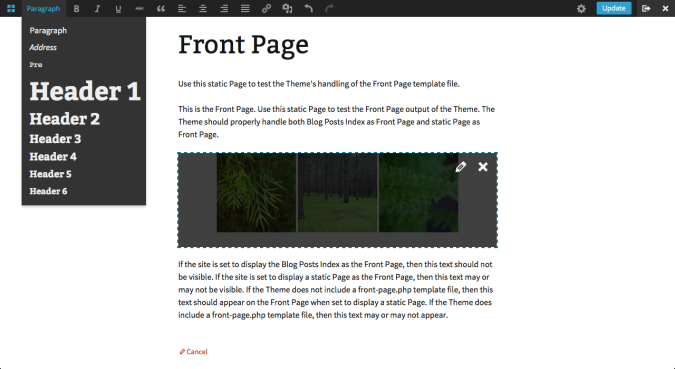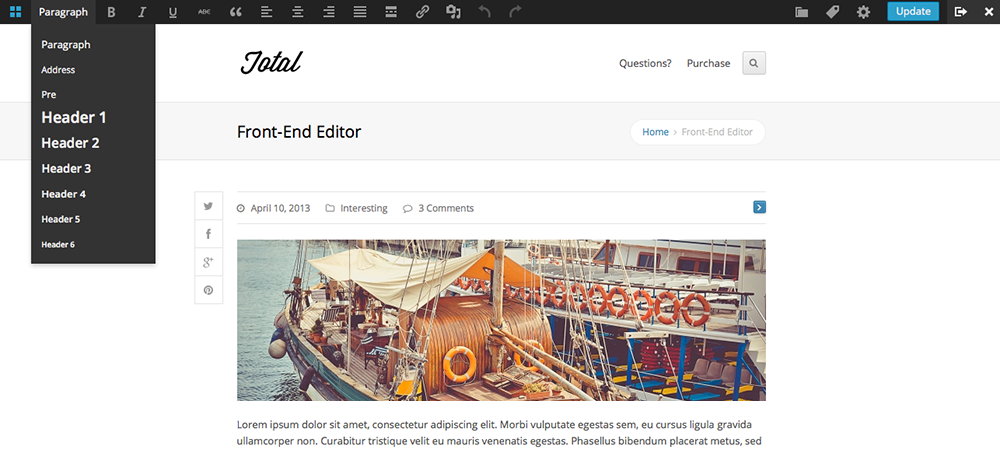Use WordPress es bastante simple, al menos en términos de escribir publicaciones de Blog y publicarlas; no es necesario ser muy conocedor de la tecnología para manejar el proceso. A pesar de todo, está a punto de volverse aún más fácil.
Soon, you will no longer need to compose your next blog post in a box that does not look like what your published post will appear. WordPress is trying to go in a new direction with the development of a front-end editor that will allow users to create posts, add images and other media, and adjust the layout of a post without having to venture into the back-end of the site. .
Esto suena muy bien para los bloggers de WordPress en todas partes. ¿Un editor de publicaciones WYSIWYG que te posibilita ver cómo se verá tu publicación en vivo, mientras la escribes? ¡El sueño de un blogger hecho realidad! Pero, ¿qué significa esto realmente para el futuro del desarrollo de WordPress en su conjunto? ¿Y qué implicaciones tendrá esto en los detalles más concretos del back-end y cómo las persons interactúan con él?
About the new front-end editor

According to a discussion in the Make the WordPress UI blog, hay muchos cambios en la user interface de front-end para WordPress y los están probando en forma de complemento. Justo después de Navidad, el equipo dirigido por Janneke Van Dorpe agregó más opciones de medios. Ahora admite enlaces oEmbed, vistas previas de la galería y leyendas, y edición de imágenes destacadas. Pero aún se esperaban más cambios.
El mayor enfoque durante la reunión del 20 de enero de 2014 fue la capacidad recién creada para realizar publicaciones y páginas desde el front-end. El nuevo editor al mismo tiempo permitirá a los usuarios cargar medios y cambiar metadata. Al mismo tiempo está configurado para incluir herramientas de edición estándar como negrita, cursiva y enlaces en la parte superior de la barra de administración.
At the same time you can see in the sample image that the paragraph options have been added to the admin bar as a WYSIWYG drop down menu. The typical buttons for paragraph alignment, quotation marks, underline, spell check, undo and redo at the same time are present. And more are likely to be added as time goes on from the "Kitchen Sink" menu bar.
Otra característica ingeniosa es la adición de ventanas modales que permitirán a los usuarios agregar campos personalizados y crear e insertar galerías sobre la marcha. Esto es un gran avance, dado que la nueva interfaz de Username posibilita a los usuarios hacer todo esto desde el front-end sin siquiera acercarse al back-end. Agrega la adición de TinyMCE 4.0 al núcleo de WordPress y dispone de una experiencia de edición más sólida. No parece tan diferente, pero tiene un mejor manejo del rendimiento.
Fast forward three weeks to February 11 and there have been even more additions to the front-end editor UI. As an example, the UI team added better title detection to work with the vast majority of themes and a nicer layout for the metadata modal. Tooltips have been added to buttons and a rudimentary autosave version. At the same time, at the same time a message box was added asking users to restore from backup.

Se harán más cambios, de todos modos, antes de que este editor de front-end se convierta en un pilar para el CMS, pero es interesante observar el proceso de desarrollo debido a que (1) es muy probable que esta be la dirección que tome WordPress de ahora en adelante y (2 ) indica qué características de la experiencia general del usuario prioriza y valora más el equipo.
Logging the last Make WordPress UI meeting at the same time indicates what's on the horizon for the UI, including more consistently built-in TinyMCE manners and post blocking. A front-end editor is destined to become a "thing" for future versions of WordPress. The question of how soon is anyone's guess.
Hay un complemento disponible que posibilita a los desarrolladores integrantes trabajar en el editor de front-end de forma dinámica. Es probable que los cambios que se desarrollen en este complemento se consideren para su inclusión en WordPress Core completo en algún momento de este año como muy pronto. WordPress no es ajeno a este tipo de desarrollo, pero siempre es interesante presenciar cómo la plataforma de Open Source se utiliza semana a semana como esta.
The effects on WordPress development
One of the biggest effects of a switch to a front-end editor is the greatly reduced risk of authors, bloggers, and contributors accidentally breaking the site or making changes without your prior approval. Manipulating a site's back-end without the proper technical knowledge could wreak havoc, so this should give developers a huge sigh of relief.
This at the same time could lead to a further division between the front-end and back-end development worlds. There will be people working on WordPress sites who won't even need to take a look under the hood of how it all works. This goes beyond the limitations of the previously defined user roles that you could set as administrator and would give authors (or anyone who prefers) access to the WYSIWYG editor only.
In the future, there will likely be dedicated WordPress "contributors" and those who simply take over the admin duties. Again, these have been defined as user roles before, but with the addition of the front-end user interface, the user experience will be profoundly different.
In conclusion, the prioritization of a front-end editor indicates a "catch up" with the recent back-end development that WordPress has already implemented in previous months. And while we've already seen a better UI look in the last major update with color scheme options and such, the new editor tries to integrate form with function. Or rather, the function of form.
Basically the next logical step is to make the back-end post editor look good to create a front-end post editor that follows the general WYSIWYG trend of dashboard menus.
¿El cambio a un editor de front-end cambiará de manera importante la apariencia y la apariencia de los sitios de WordPress? No. Del lado del client, todo está configurado para que se vea más o menos igual y así debería ser. Pero al cambiar la forma en que los autores y desarrolladores interactúan con WordPress, seguramente veremos avances significativos en la interfaz de usuario del panel. Fueron already seeing that, indeed, and it's an exciting time to be involved in the development, let me tell you.
If you want to see the progress of the front-end editor, you can download it now and have a try. Just know that it is under construction and it will change a lot as the weeks go by. Better to test this on a local host for now. It's definitely not ready for the customer's site, so keep that in mind as you poke around.
At the same time you can contribute to the plugin and its development, if you wish. Just browse the open tickets on the plugin page in the WordPress directory to see what needs to be worked on next. Anyway, only developers who really know what they are doing should dive in, which should be common sense at this point.
So, are you excited about the possibility of a front-end editor hitting the WordPress core later this year? Or do you prefer to stick to a back-end approach? Speak up in the comments and let us know what you think!






